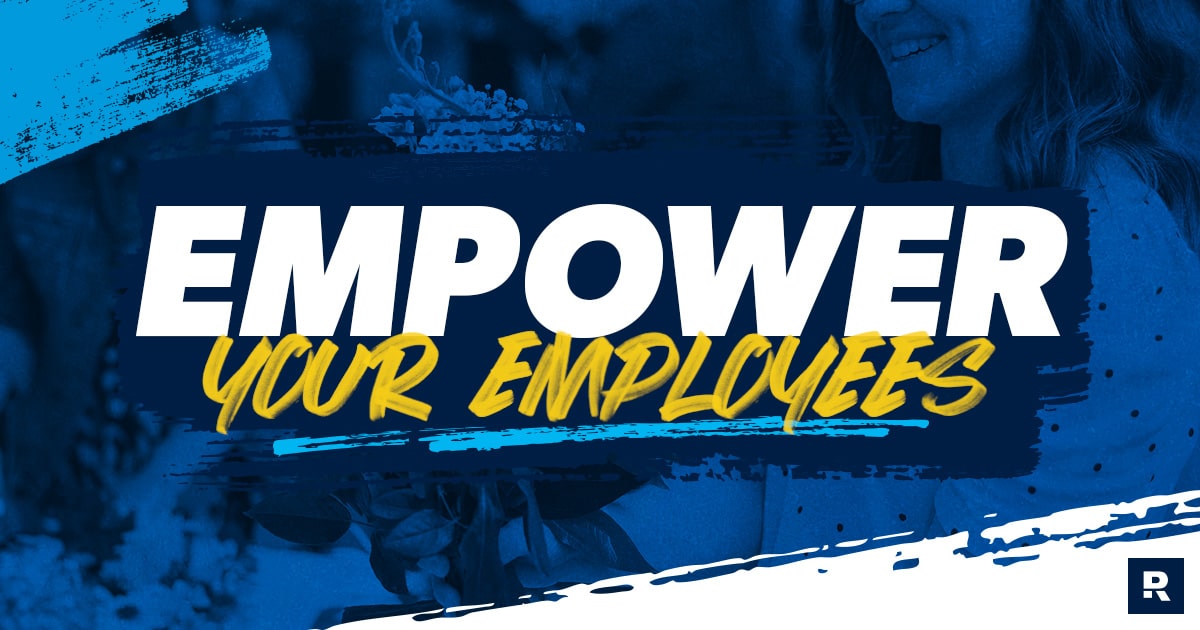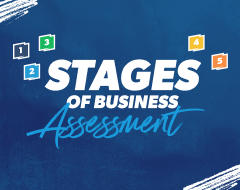Employee Empowerment: Why It Matters and 12 Ways to Empower Your Team
9 Min Read | Sep 30, 2025

Key Takeaways
- You empower your employees when you give them the freedom, resources and clear expectations they need to do their best work.
- You can empower your team by:
- Setting and modeling healthy expectations
- Training and living out what you want to reproduce
- Giving people the go-ahead and support to do their jobs
- Providing feedback and vision so your team keeps growing
- Employee empowerment leads to greater unity, improved creativity and a stronger bottom line.
Ready to Level Up Your Business?
Find out your Stage of Business with our free assessment and get free resources to help you level up by focusing on the right things at the right time.
Employee empowerment. It’s one of those phrases that can mean just about anything—and go sideways fast if you’re not careful. When done wrong, it turns into a wild west rodeo show where team members charge into work whenever they want, shoot from the hip all day, then ride off into the sunset, leaving chaos behind them. But when it’s done well? Empowerment gives your team the freedom to take ownership, make smart decisions, and use their talents to hit important business goals—like expert sharpshooters.
So how do you empower your employees to feel valued and trusted while still guiding them toward your business goals? We’ll get to that. But first, let’s clear up any confusion about what employee empowerment really means.
Then we’ll walk through 12 proven ways to build it into your leadership and company culture.
What Is Employee Empowerment?
Employee empowerment sounds fancy, but it’s actually pretty simple. You empower your employees when you give them the freedom, resources and clear expectations they need to do their best work. They know what you expect them to do, and you’ve given them the training and the go-ahead to do it. You also give them regular, productive feedback to build their decision-making skills so they can impact processes and generate great ideas for your business.
12 Ways to Empower Your Employees and Boost Employee Success
If that’s what real employee empowerment can do, bring on an empowerment revolution, right? Check out these 12 ways you and your leadership team can become empowerment engines and set your team up to give their best.
Set and model healthy expectations.
1. Hire well. How do you build a culture of excellence? Start by hiring rock stars. Look for smart, talented, humble people who are fired up to do high-quality work. And communicate those values from the screening process to onboarding to daily operations.
2. Clarify roles. Don’t assume people know how to do things your way. Role clarity means spelling out responsibilities and clearly communicating what winning looks like.
3. Keep a handle on work-life balance. When your team has healthy boundaries between work and home, they’ll be more productive—and more satisfied. Set the tone by sending a clear message: At work, focus fully on work. At home, be fully present at home. And if you’re on a trip or intentionally taking time away, for goodness’ sake, stop constantly checking your email. This “be where you are” mindset empowers your team to show up—mentally and emotionally—where it matters most.
Train for and live out what you want to reproduce.
4. Lead with integrity. If you expect people to conduct themselves with integrity, lead with integrity. Loyalty is born and a quality culture is built when the leader follows through in a predictable, positive and proactive way on every issue and opportunity.
5. Develop your team. Investing in your team’s growth isn’t just good leadership—it’s a clear sign you value them. Upskilling (training your people in new skills and coaching them to grow in areas they’re already strong) keeps your team challenged, engaged and moving forward. And when they get better, so does your business.
6. Reward good work. When a team member consistently brings their A game, reward their effort with more opportunities to grow—in the form of greater authority, bigger and more responsibilities, or even an entirely new role.
Give people the go-ahead and support to do their jobs.
7. Delegate—the right way. Your business will never grow beyond your ability to train and trust your team to share responsibilities so everyone gets more done. Keep in mind, though, that delegation isn’t about pushing off what you don’t like to do. It’s about recognizing your team members’ skills and abilities, then trusting them to take on more responsibilities.
8. Emphasize the self-employed mentality. Teach your team members to own not just their role but also the success and well-being of your business. Empowered employees pick up the trash they see on the ground coming into work. They look at company profits and expenses as factors that are within their power to influence. And they see their job as a chance to do what they do best every day to reach the company’s goals.
9. Ask for input. As the saying goes, “If you want to go faster, go alone. If you want to go farther, go together.” That goes for learning from the opinions, skills and expertise of the people you hired. Input can be as simple as doing feedback surveys after events. Or getting a handful of team members to share what they know about a new business tool you’re considering. It could also be hashing out a business problem with your sales team, then trusting them to solve it. With regular input, your team will know their insights count—and you’ll make better decisions.
Provide feedback and vision so your team keeps growing.
10. Give regular feedback. As a great leader, you care about how your team is doing. But you may not always do the best job checking in with them when you’re busy putting out fires all day. Regular meetings and conversations keep you and your team members in sync. Use annual reviews to look at high-level progress and identify opportunities to improve performance moving forward. And build in weekly reports and weekly or biweekly one-on-ones for real-time feedback—and a chance to celebrate their wins.
11. Communicate well. By this we mean a few things: Handle hard conversations with individual team members quickly, calmly and privately. That’s called healthy conflict, and it’s essential for the growth of your team and your business. Also, have regular conversations with your entire team about your mission, vision and values—because when they’re confident about where you’re headed as a company, they’ll rally with you to get there.
12. Show appreciation. It takes just a few minutes and costs almost nothing to say thank you for a job well done. Your attitude of gratitude shows you care and boosts your team members’ confidence and productivity—and it boosts the likelihood they’ll stay with your business. It’s also a great way to reward behaviors you want your team members to keep doing!
Benefits of Employee Empowerment
Building an empowered team isn’t easy. Leaders have a lot of work to do to find great people and consistently pour into them. But the payoff—benefits like greater unity, improved creativity, motivated employees and a stronger bottom line—is worth it.
Greater unity: When you show you care about employee success and believe in your team, they feel safe and trust you in return. That trust breeds unity, and unity makes you an unstoppable force in your market!
Armando Lopez, senior executive director of human resources at Ramsey Solutions, encourages business leaders to get to know their people as people, not as cogs in a machine. “Over time, that rapport helps you see their strengths so you can develop their potential,” he explains. “Before you know it, you’ve gained credibility and trust, then influence and a unified partnership toward your mission.”
Improved creativity: Empowered team members also solve business problems with creativity and confidence. Try new copy and artwork concepts? No problem. Run more split tests? Abso-freaking-lutely. Squeeze more bang out of your digital marketing bucks? On it! Why? Because they know you’ll hear their ideas and value their input. And that’s just what they need to think fearlessly and innovate responsibly.
Motivated employees: What’s another by-product of empowerment? Hungry, driven team members who take on extra projects and go the extra mile to serve their teammates and customers. Heck, even off the clock they’ll probably rave to anyone who’ll listen about being part of your company and doing work that matters.
Stronger bottom line: Companies who empower employees are just more profitable—23% more, in fact.1 Workers who feel micromanaged and beaten down, on the other hand, will check out and underperform. That disengagement cost the global economy $438 billion in 2024.2 The takeaway? Empowered teams care about their work. And that leads to greater job satisfaction, higher productivity and stronger retention.
Employee Empowerment Mistakes to Avoid
As great as empowering employees can be for your business, beware of these three empowerment mistakes:
- Increasing responsibilities before you build rapport, credibility and trust: Instead of your team member feeling empowered, they’ll feel burdened and stressed. Even worse, they may worry they can’t come to you for help.
- Turning a team member loose to “go be great” before they’re even up to speed in their role: If you aren’t helping, you aren’t helping. In other words, if you haven’t given them clear expectations and the training and resources to succeed, they probably won’t.
- Passing off work you don’t like to do in the name of empowerment: That’s just gross. If you need help and they’re a better fit for the job, say so—and make it a win for everyone. Do you trust them to handle a task so you’re freed up for other important responsibilities? Are they better wired to make a process run smoother? Are they more energized with fresh ideas to lift a project? That’s awesome! Empower them to do more—and give them a pay bump, new title or path to a bigger role. But don’t just dump on them. Great leaders are also great people builders.
Be an Empowering Leader
One final word to empower you: Employee empowerment isn’t an HR thing or a checkbox on a leadership to-do list. It’s a mindset. And ultimately, it’s your responsibility as the leader. The truth is, no one has more influence on your team’s morale, creativity and productivity than you do. That’s a big deal—and a huge opportunity.
Empowering leaders don’t try to control every move. They coach. They develop. They delegate with confidence. And they cheer their team on every step of the way. If you want to build a thriving business full of hungry, humble, smart people who are in it to win it, be that kind of leader.
What's Next: Be an Empowering Leader
- Watch or listen to The EntreLeadership Podcast and hear Dave Ramsey give advice on leadership and business-related topics.
- Take the Stages of Business Assessment so you’ll know what to focus on next to help your employees be and give their best.
- Join EntreLeadership Elite™ and get access to tools and resources that will help you empower your team and take your business to the next level.

